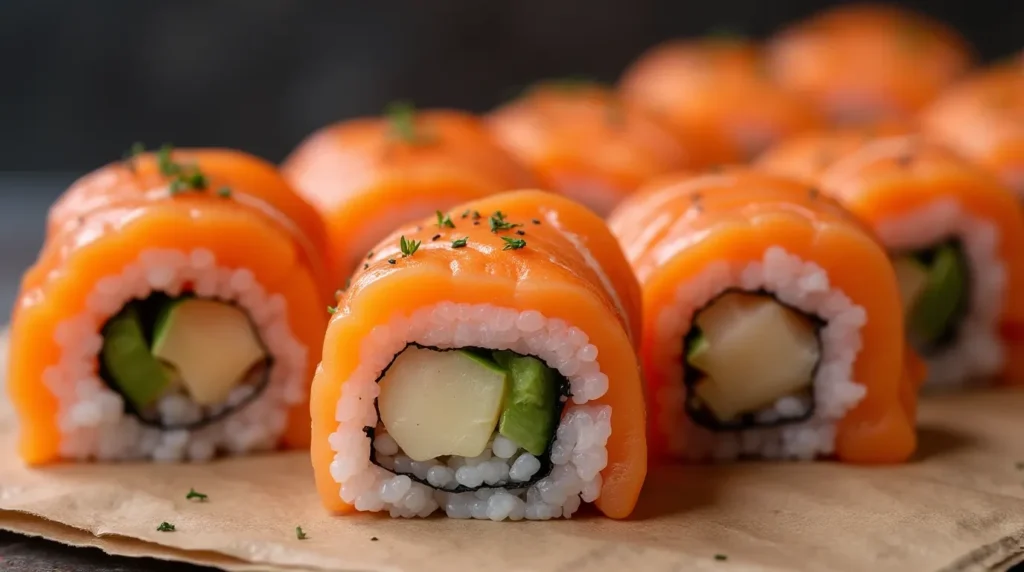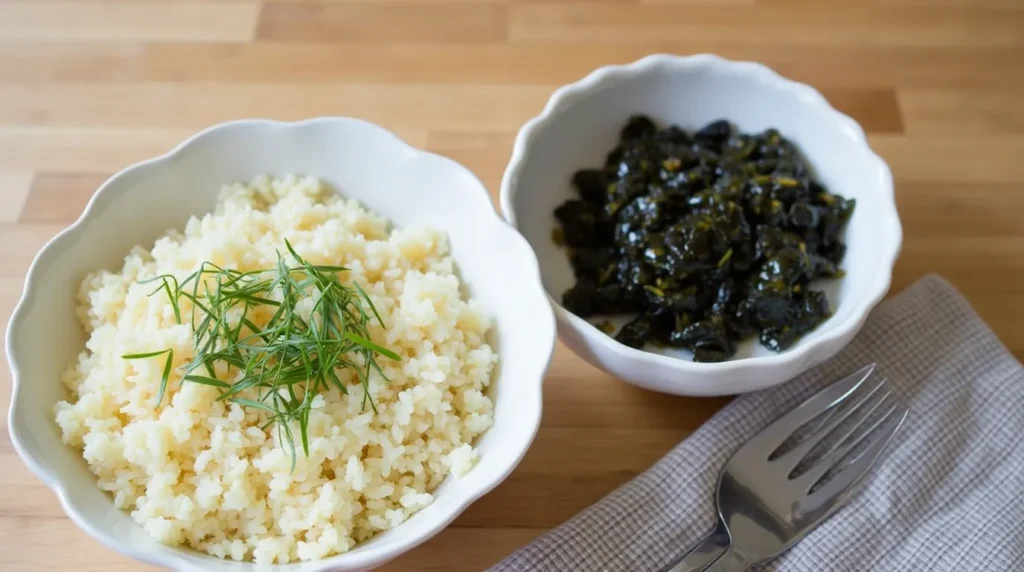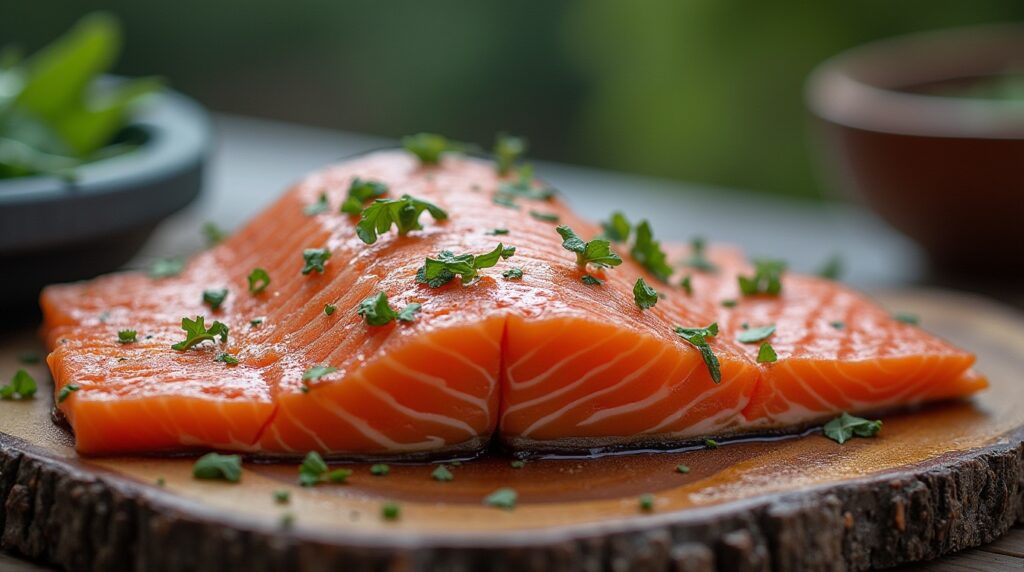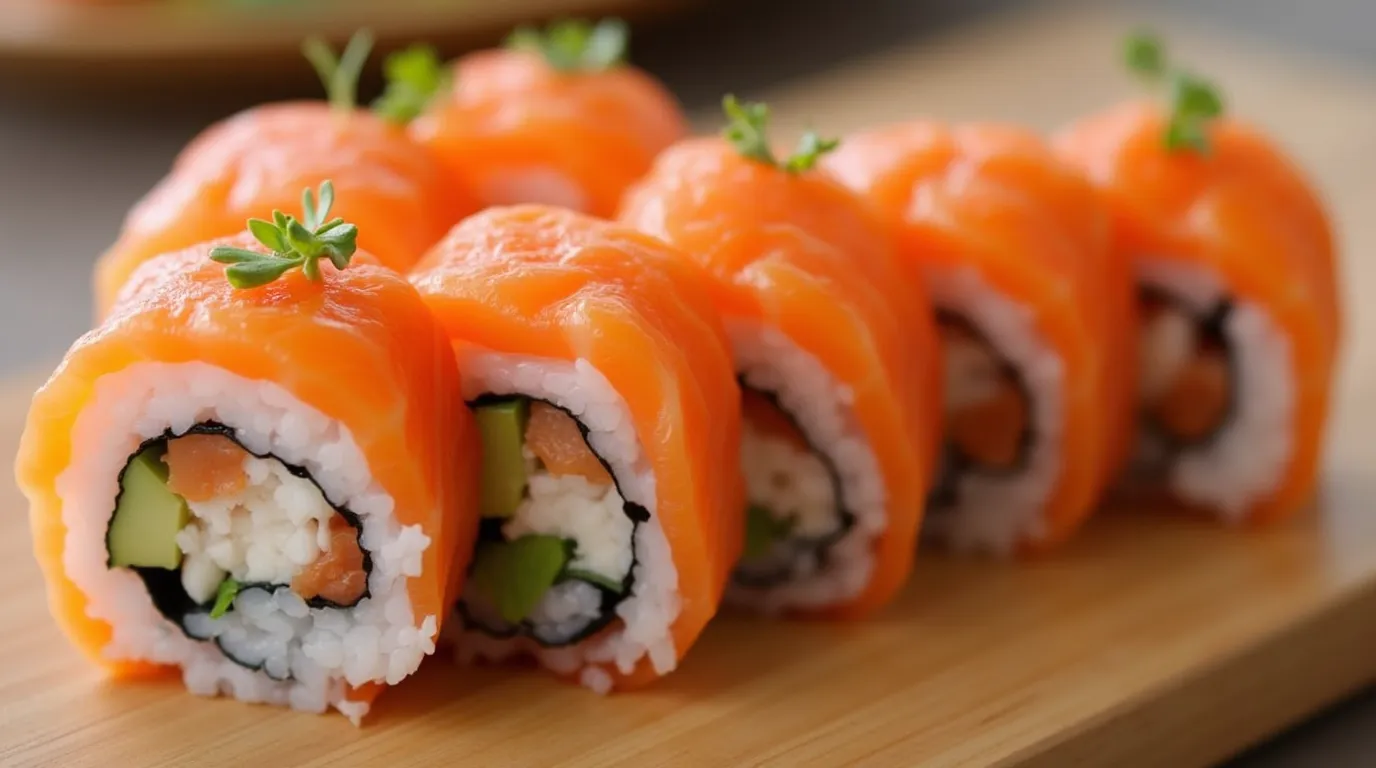Wondering What does a salmon roll have? Well, i’m excited to share with you the essential ingredients and preparation of salmon rolls. This popular sushi dish has gained worldwide recognition. A salmon roll typically includes sushi-grade salmon, crab, avocado, and cucumber.
These ingredients provide a balance of flavors and textures. When it comes to a salmon roll recipe, the ingredients are carefully selected. This ensures a delicious and healthy meal.
As I explore the world of salmon rolls, I’ll look at the various components. This includes the salmon roll ingredients and the preparation process. Making a salmon roll takes only 25 minutes, making it a fun and rewarding experience.
Whether you’re a seasoned sushi lover or just starting to explore, understanding what a salmon roll has to offer is key. It’s essential to appreciate this popular dish.
Understanding the Classic Salmon Roll

I’m really into sushi, and the classic salmon roll catches my eye. It’s a simple yet tasty dish from Japan. It’s made with sushi rice, nori seaweed, and salmon. These ingredients come together to create a perfect mix of flavors and textures.
There are many fillings you can use in a salmon roll. You can go for traditional salmon or try something new like smoked salmon or crab. You can also add avocado, cucumber, or pickled ginger on top. But the core ingredients of sushi rice, nori seaweed, and salmon are what make it special.
Basic Components
The salmon roll has its roots in Japan’s Edo period. Back then, it was a snack. The main parts of a salmon roll are sushi rice, nori seaweed, and salmon. These ingredients are what make the dish so iconic and tasty.
Traditional Japanese Origins
In Japan, the salmon roll is often topped with things like cucumber and avocado. The Japanese way of making sushi is all about keeping it simple and fresh. They use only the best ingredients, which is what makes the classic salmon roll stand out.
Modern Adaptations
Today, the salmon roll has many different toppings and fillings. You can find everything from spicy mayo to toasted sesame seeds. But even with all these new options, the traditional ingredients are always at the heart of the dish. Whether you like the old-fashioned way or the new twists, the salmon roll is a favorite among sushi fans.
| Salmon Roll Type | Ingredients | Toppings |
|---|---|---|
| Classic Salmon Roll | Sushi rice, nori seaweed, salmon | Avocado, cucumber, pickled ginger |
| Smoked Salmon Roll | Smoked salmon, sushi rice, nori seaweed | Cream cheese, capers, thinly sliced red onion |
| Spicy Salmon Roll | Spicy tuna, sushi rice, nori seaweed | Salmon sashimi, cucumber, spicy mayo |
Essential Rice and Seaweed Base

Creating a tasty salmon roll starts with a solid base. The rice and seaweed base is key. It gives the roll structure and flavor that goes well with the salmon.
Japanese sushi rice is perfect for this. It’s a short-grain rice that sticks together well when cooked. This makes it great for salmon sushi.
The rice gets a special flavor from rice vinegar, sugar, and salt. Nori seaweed sheets add crunch and a salty taste. To make sushi rice, use short-grain brown or white rice for stickiness.
Making salmon rolls can be affordable. A recipe costs $12.95, and each roll is about $2.59.
Important ingredients for salmon rolls include: * Short-grain brown rice or white sushi rice * Nori seaweed sheets * Salmon (canned, shiozake, or leftover/fresh) * Soy sauce or tamari for seasoning * Fish sauce for umami flavor These help make a delicious, authentic salmon roll. The rice and seaweed base is the foundation.
The Star Ingredient: Salmon Options and Preparation

Choosing the right salmon is key to a great salmon roll. Fresh, sushi-grade salmon is the best choice. You can use raw or smoked salmon. Raw salmon is known for its delicate taste and firm texture.
Smoked salmon adds a rich, savory flavor. It’s important to store and handle the salmon right. Keep it in a sealed container in the fridge and handle it gently.
Raw Salmon (Sashimi Grade)
Raw salmon is a favorite for its taste and texture. Look for sushi-grade salmon that’s been frozen to kill parasites. This ensures it’s safe to eat raw and tastes best.
Smoked Salmon Varieties
Smoked salmon brings a deep flavor to rolls. There’s hot-smoked and cold-smoked salmon. Hot-smoked is firmer and more flavorful, while cold-smoked is softer and milder.
| Salmon Type | Flavor | Texture |
|---|---|---|
| Raw Salmon (Sashimi Grade) | Delicate | Firm |
| Smoked Salmon | Rich and Savory | Varies |
Knowing about different salmon types helps you make a top-notch salmon roll. Whether you like raw or smoked salmon, quality ingredients and proper handling are key.
What Does a Salmon Roll Have Inside?
Salmon rolls offer a variety of exciting fillings. They often include crab, avocado, and cucumber. These ingredients mix flavors and textures well. Toppings like sesame seeds and soy sauce add extra flavor and aroma.
Wasabi and pickled ginger can also make your meal better. To make a salmon roll, you need cooked rice, nori sheets, raw salmon, cream cheese, lettuce, and rice vinegar. Here’s a list of common ingredients:
- 200g Salmon Fillet
- 7 oz Cream Cheese
- 1 handful of Lettuce
- 1 ripe Avocado
- 1/2 an English cucumber
- 8 sheets of toasted nori seaweed
These ingredients can be mixed in many ways. You can add spicy sauce or Japanese mayonnaise for extra flavor. Salmon rolls are loved in many places because of their variety.
| Ingredient | Quantity |
|---|---|
| Salmon Fillet | 200g |
| Cream Cheese | 7 oz |
| Lettuce | 1 handful |
| Avocado | 1 ripe |
| Cucumber | 1/2 |
| Nori Seaweed | 8 sheets |
Trying different fillings, toppings, and sides can make a salmon roll your own. Whether you love sushi or are new to Japanese food, salmon rolls are a must-try.
Common Vegetable Fillings and Textures
Vegetables are key in salmon roll fillings, adding texture and flavor. Cucumber and avocado are favorites, with cucumber’s crunch and avocado’s creaminess. They’re also great as toppings, boosting flavor and looks.
Carrots and asparagus can also spice up salmon rolls. They bring color and taste, making the dish more fun and tasty. Japanese short-grain rice is a must, and Mizkan Seasoned Rice Vinegar makes it even better.
Some top picks for vegetable fillings are:
- Cucumber, which provides a refreshing crunch
- Avocado, which adds a creamy texture
- Carrots, which add a sweet and crunchy element
- Asparagus, which brings a subtle earthiness to the dish
By mixing these ingredients, you can create unique and tasty salmon roll fillings and toppings.
Popular Toppings and Garnishes
Salmon roll toppings offer endless choices. Classic favorites like soy sauce, wasabi, and pickled ginger bring out the flavors. Other favorites include sesame seeds, grated daikon, and thinly sliced scallions.
Looking to make your salmon sushi even better? There are many accompaniments to try. Here are some popular ones:
- Tobiko (fish roe) for added texture and flavor
- Spicy mayo for a creamy, spicy kick
- Furikake seasoning for a savory, umami flavor
Choosing the right toppings and accompaniments is key. Fresh, sushi-grade salmon is a must. Use trusted vendors like Honolulu Fish Company or Whole Foods’ sushi sections for the best quality. The right mix of toppings and accompaniments can make salmon sushi unforgettable.
| Topping | Description |
|---|---|
| Soy Sauce | A classic topping that adds a salty, savory flavor |
| Wasabi | A spicy condiment that adds a pungent flavor |
| Pickled Ginger | A sweet and sour topping that adds a burst of flavor |
Sauces and Condiments
To finish a salmon roll recipe, you need the right sauces and condiments. Learning how to make a salmon roll means knowing how these ingredients work. The best ingredients often mix traditional Japanese flavors with new sauce ideas.
Traditional Japanese flavors like soy sauce and wasabi are key in salmon rolls. They give the dish a unique taste and smell. For a simple start, try smoked salmon, cucumber, and avocado.
Modern Sauce Variations
Modern sauces, like spicy mayo and sriracha, bring a bold taste to salmon rolls. You can mix these with traditional flavors for a special taste. Think about the flavor you want when picking your ingredients.
Spicy Options
If you like a bit of heat, wasabi and diced jalapenos are great. Use them carefully to keep the other flavors balanced. Trying different sauces and condiments helps you find the perfect mix for your salmon roll.
Regional Variations and Special Rolls
There are countless ways to make a salmon roll. Each region brings its own twist to this dish. Exploring these variations is key to mastering the salmon roll.
Salmon roll recipes vary by location. American rolls might include crab and avocado for extra creaminess. On the West Coast, spicy tuna and crab add a bold taste. East Coast rolls often feature lobster and caviar for luxury.
Exploring Regional Twists
Some rolls, like the California roll, add a Western flair with pickled ginger and soy sauce. Korean Kimbap and Hawaiian Poke bowls also inspire salmon roll recipes. Mixing traditional ingredients with new flavors creates a unique dish.
Trying new salmon roll recipes is exciting. Exploring regional variations helps you find the perfect flavor. You’re bound to discover a combination that you love.
Conclusion: Crafting the Perfect Salmon Roll Experience
Creating the perfect salmon roll is a rewarding culinary journey that blends quality ingredients, careful preparation, and a touch of creativity. By mastering the basics—such as selecting the right sushi rice, crisp nori, and fresh salmon—you lay the foundation for a delicious and visually stunning roll. Whether you choose raw sashimi-grade salmon, smoked salmon, or a combination of both, each option brings its own unique flavor and texture to the table.
Elevate your rolls by incorporating a balance of textures and flavors, from crisp cucumbers and creamy avocado to specialty ingredients like pickled ginger or mango. Don’t forget the finishing touches, such as sesame seeds, spicy mayo, or eel sauce, to add depth and visual appeal. Experiment with regional and specialty rolls, drawing inspiration from classic styles, West Coast innovations, East Coast influences, or even fusion creations to keep your sushi game exciting and diverse.
With sharp tools, fresh ingredients, and a bit of practice, you can roll like a pro and present beautifully crafted salmon rolls that impress everyone at the table. Whether you’re a sushi novice or a seasoned home chef, the key to success lies in attention to detail and a willingness to explore new flavors. So, grab your bamboo mat, gather your ingredients, and let your creativity shine as you craft salmon rolls that are as delightful to eat as they are to make.
FAQ
What does a salmon roll have?
A salmon roll is a favorite sushi dish. It has sushi-grade salmon, crab, avocado, and cucumber. These ingredients are chosen for their taste and texture.
What are the basic components of a salmon roll?
A salmon roll has sushi rice, nori seaweed, and salmon. It comes from Japan, where sushi was first enjoyed as a snack.
How is the rice and seaweed base prepared for a salmon roll?
The rice and seaweed base is key to a salmon roll’s taste and feel. Japanese sushi rice is special because it sticks together well. It’s seasoned with vinegar, sugar, and salt for flavor. Nori seaweed adds crunch and saltiness.
How is the salmon prepared for a salmon roll?
The salmon is the main ingredient. It can be raw or smoked. Raw salmon is called sashimi-grade. Smoked salmon adds a rich flavor. Keeping the salmon fresh and safe is important.
What other fillings and toppings are commonly used in a salmon roll?
Salmon rolls have many fillings and toppings. Crab, avocado, and cucumber are common. They add different tastes and textures. Toppings like sesame seeds and soy sauce add flavor and aroma.
What are some popular vegetable fillings and textures used in a salmon roll?
Vegetables add flavor and texture to salmon rolls. Cucumber and avocado are favorites for their freshness. Carrots and asparagus add color and taste. Sesame seeds and tempura bits add crunch.
What are some popular toppings and garnishes for a salmon roll?
Salmon rolls can have many toppings and garnishes. Soy sauce, wasabi, and pickled ginger are classics. Sesame seeds, daikon, and scallions are also popular.
What sauces and condiments are commonly used with a salmon roll?
Sauces and condiments make salmon rolls tasty. Soy sauce and wasabi are traditional. Spicy mayo and sriracha add a modern twist. Wasabi and jalapenos add heat.
What are some regional variations and special rolls of salmon rolls?
Salmon rolls vary by region. American rolls often have crab and avocado. West Coast rolls might have spicy tuna. East Coast rolls might have lobster and caviar for luxury.

